How to Fix a Slow Loading WordPress Dashboard
Slow loading of WordPress dashboard
Do you also feel that your WordPress dashboard is loading slowly?
A slow-loading WordPress dashboard is annoying and hurts your overall content creation and website management productivity. Also, the main reason for the slow loading of the WordPress dashboard can affect your visit statistics.
This article will show you how to fix the slow-loading WordPress dashboards easily.
What causes the WordPress dashboard to load slowly?
Many reasons can cause a slow-loading WordPress dashboard, but the most common ones are limited server resources or a weak host. However, as your WordPress website grows, you may notice a slight decrease in performance or slower loading on all of your pages. This is usually because more people are now accessing your website and consuming server resources.
For the front end of your website that your visitors see, you can easily install a WordPress cache plugin to overcome WordPress speed and performance issues.
However, the slowness of the WordPress admin area is not solved by cache plugins, so it needs more resources to run at an optimal level.
If your WordPress dashboard is annoyingly slow, a WordPress plugin, a default setting, or something else on the site is consuming too many resources.
In the following, we will examine the methods to solve the problem of the slowness of the WordPress dashboard.
1. How to test the functionality of the WordPress admin area
Before making any changes, it is important to measure the speed of your WordPress admin area. Normally, you can use website speed test tools to check the speed and performance of your website.
Fortunately, many modern desktop browsers have built-in tools to test the performance of any web page you want.
For example, if you’re using Google Chrome, you can go to your WordPress dashboard and open the Inspect tool by right-clicking anywhere on the page.

This will open a new window on your browser page, and you will see the Inspect area in another window at the bottom or side of your browser window.
Inside the Inspect tool, go to the Lighthouse tab and click the Generate Report button. This will generate a report similar to the Web Vitals report produced by Page Speed Insights.
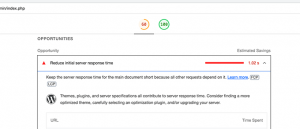
From here, you can see what is slowing down your WordPress admin. For example, you can see which JavaScript files are taking up more resources and affecting your server’s initial response time.
2. Install WordPress update
The core WordPress team works hard to improve functionality in every WordPress release to maximize WordPress performance. For example, the block editor team tests and improves performance in each release. The performance team works on improving speed and performance in all departments.
If you don’t install WordPress updates, I suggest you do. Because every update is better than the previous version, similarly, all the top WordPress themes and plugins release updates that fix bugs and performance issues.
Go to Dashboard » Updates to install available updates to install updates.
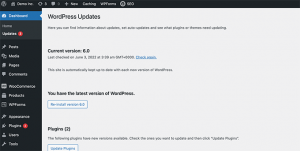
3. Update the PHP version used by your hosting company.
Another way to get rid of the slow loading of the WordPress dashboard is to update PHP. WordPress is developed using an open-source programming language called PHP. When writing, WordPress requires at least PHP version 7.4 or higher. The current stable version available for PHP is version 8.1.6.
Ded9.com’s WordPress hosts have the maximum configuration for the best experience hosting WordPress sites. For WordPress hosting prices and purchases, click on the banner below.
Most WordPress hosting companies have minimum requirements to run WordPress. Like WordPress, PHP releases new versions with significant performance improvements. You may not get that performance boost using an older version.
You can see which version of PHP your hosting provider is using by visiting the Tools » Site Health page of your WordPress dashboard and switching to the “Info” tab.
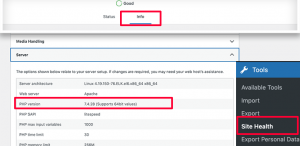
All reliable WordPress hosting providers like Ded9.com Provide an easy way for customers to upgrade their PHP version.
Just enter the host’s control panel (for example, cPanel) and look for the MultiPHP Manager option. Change the PHP Version and click Apply.

4. Increasing the PHP memory limit
Increasing the amount of memory can also help to solve the problem of slow loading of the WordPress dashboard. Your web hosting server is like any other computer. It requires memory to run multiple programs at the same time efficiently. If your server does not have enough memory for PHP, it will slow down your website and may even cause it to crash.
You can see the PHP memory limit by going to the Tools » Site Health page and the Info tab.

You will find the PHP memory limit in the Server section. If it is less than 500M, you need to increase it.
You can increase the PHP memory limit by adding the following line to your wp-config.php file.
define( ‘WP_MEMORY_LIMIT’, ‘512M’ );
5. Using WordPress performance monitoring plugins
Some WordPress plugins may run in the WordPress admin area. If plugin developers are not careful, their plugins can easily consume a lot of resources and slow down the loading speed of your WordPress admin dashboard.
One of the best options is the Query Monitor plugin. After activation, a new menu item will be added to your WordPress toolbar.
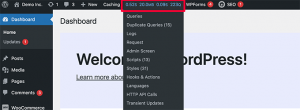
Clicking on it will show the performance results of the page you currently view on your website.
You need to go to the Queries by Component tab on the left. From here, you can see the performance impact of plugins and find out which ones are taking up too many resources.

Now you can temporarily disable plugins that you think are causing slowness and see if that improves performance.
6. Installing the WordPress cache plugin
WordPress cache plugins not only improve the speed of your website but can also help you fix the slow loading of the WordPress admin dashboard. A good WordPress caching plugin will help optimize page load speed, CSS and JavaScript delivery, your WordPress database, and more.
These plugins free up your WordPress hosting server resources that your WordPress admin can use to improve performance.
We recommend using WP Rocket. It is the best WordPress cache plugin at the moment.
7. Optimized management pages and disabled dashboard widgets
WordPress automatically loads some widgets on the dashboard page. That includes quick draft, events and news, site health, and more.
Some WordPress plugins also add their widgets to the dashboard page. If you load too many of these widgets on your WordPress dashboard, it can slow down loading. You can turn off these widgets simply by clicking the Screen Options button and removing the check box next to the widgets.
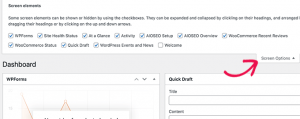
Similarly, you can use the screen options menu to show and hide sections on different admin screens. For example, you can select the columns you want to see on the posts page.
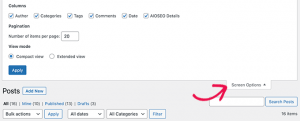
8. Fixing the slowness of the WooCommerce management dashboard
If you’ve set up an online store using WooCommerce, some specific WooCommerce features can affect the performance of your WordPress admin area. For example, you can turn off the WooCommerce dashboard widget by clicking the Page Options menu.

After some time, your WooCommerce store may send and add unnecessary data to your WordPress database. If you are using WP Rocket, you can go to the Database tab in the plugin settings. From here, you can remove transients and optimize your WordPress database with one click.

9. Manage WordPress autosave intervals
The WordPress block editor has a built-in auto-save feature. It lets you easily restore your content if you close the editor without saving your changes.
But, if multiple users work on your website during peak traffic times, all those autosave requests will slow down the WordPress admin area.
Now autosave is a very important feature, and we don’t recommend turning it off. However, you can slow it down to reduce the performance impact.
Just add the following line to your wp-config.php file. This line tells WordPress to run autosave every 2 minutes (120 seconds) instead of every 1 minute.
define(‘AUTOSAVE_INTERVAL’, 120)
Reduce Heartbeat API calls
WordPress uses the Heartbeat API to send Ajax calls to the server without reloading the page. This allows WordPress to show other authors that a post is being edited by another user and allows plugin developers to show you notifications simultaneously.
By default, the API pings once every 60 seconds. If multiple authors work on your website simultaneously, these server calls can become resource intensive.
If you are using WP Rocket, it will automatically reduce Heartbeat API activity to pingback every 120 seconds.
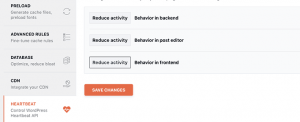
Also, you can use their standalone plugin, Heartbeat Control, to reduce Heartbeat API calls.
We recommend reducing them to at least 120 seconds or longer.
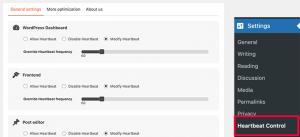
10. Change your hosts.
You should change your hosts if none of the above methods worked for you. I suggest you use the optimized hosts for WordPress to get the best results. If you want the best hosting of your choice very quickly, click on the banner below to be directed to the Ded9.comWordPress hosting purchase page.
We hope this article helps you learn how to fix the slow-loading WordPress dashboard. If it is useful for you, introduce us to your friends.











